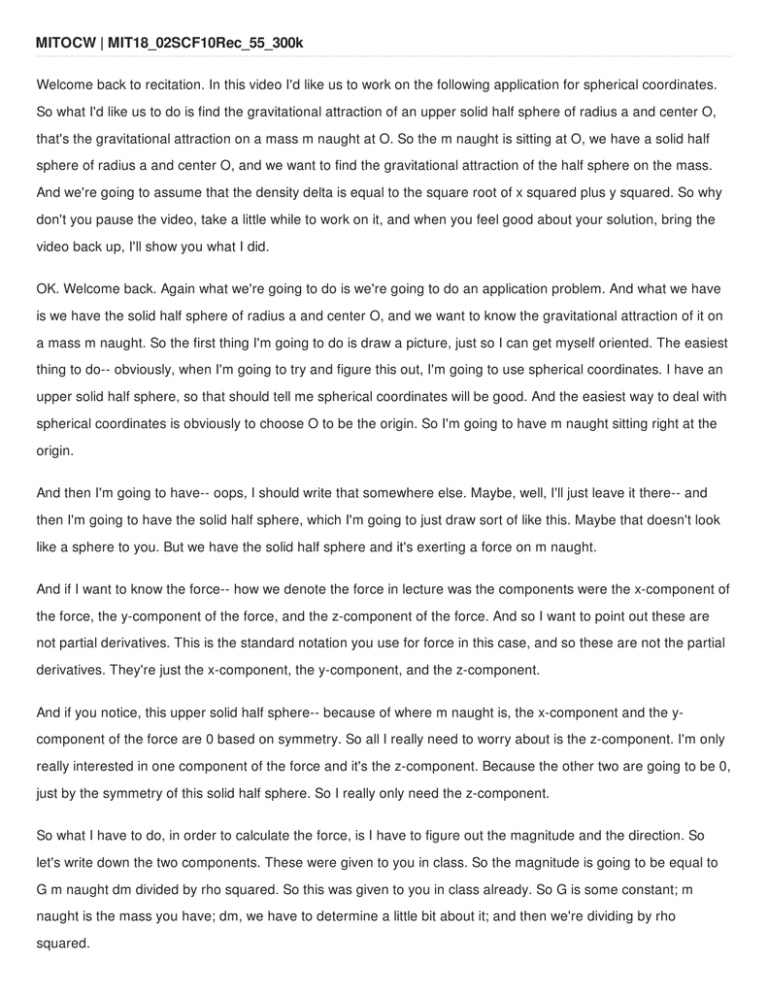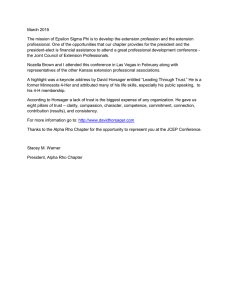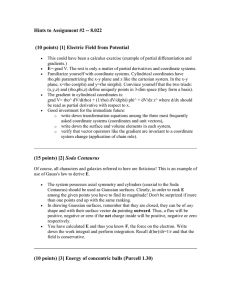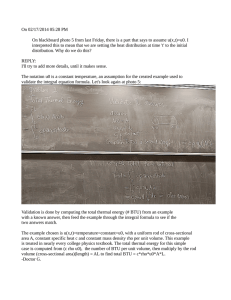MITOCW | MIT18_02SCF10Rec_55_300k
advertisement

MITOCW | MIT18_02SCF10Rec_55_300k Welcome back to recitation. In this video I'd like us to work on the following application for spherical coordinates. So what I'd like us to do is find the gravitational attraction of an upper solid half sphere of radius a and center O, that's the gravitational attraction on a mass m naught at O. So the m naught is sitting at O, we have a solid half sphere of radius a and center O, and we want to find the gravitational attraction of the half sphere on the mass. And we're going to assume that the density delta is equal to the square root of x squared plus y squared. So why don't you pause the video, take a little while to work on it, and when you feel good about your solution, bring the video back up, I'll show you what I did. OK. Welcome back. Again what we're going to do is we're going to do an application problem. And what we have is we have the solid half sphere of radius a and center O, and we want to know the gravitational attraction of it on a mass m naught. So the first thing I'm going to do is draw a picture, just so I can get myself oriented. The easiest thing to do-- obviously, when I'm going to try and figure this out, I'm going to use spherical coordinates. I have an upper solid half sphere, so that should tell me spherical coordinates will be good. And the easiest way to deal with spherical coordinates is obviously to choose O to be the origin. So I'm going to have m naught sitting right at the origin. And then I'm going to have-- oops, I should write that somewhere else. Maybe, well, I'll just leave it there-- and then I'm going to have the solid half sphere, which I'm going to just draw sort of like this. Maybe that doesn't look like a sphere to you. But we have the solid half sphere and it's exerting a force on m naught. And if I want to know the force-- how we denote the force in lecture was the components were the x-component of the force, the y-component of the force, and the z-component of the force. And so I want to point out these are not partial derivatives. This is the standard notation you use for force in this case, and so these are not the partial derivatives. They're just the x-component, the y-component, and the z-component. And if you notice, this upper solid half sphere-- because of where m naught is, the x-component and the ycomponent of the force are 0 based on symmetry. So all I really need to worry about is the z-component. I'm only really interested in one component of the force and it's the z-component. Because the other two are going to be 0, just by the symmetry of this solid half sphere. So I really only need the z-component. So what I have to do, in order to calculate the force, is I have to figure out the magnitude and the direction. So let's write down the two components. These were given to you in class. So the magnitude is going to be equal to G m naught dm divided by rho squared. So this was given to you in class already. So G is some constant; m naught is the mass you have; dm, we have to determine a little bit about it; and then we're dividing by rho squared. And the direction-- because I'm only interested in the z-component-- the direction is just z, but then I want to make sure that the direction component is z divided by rho. The full direction is [x, y, z] divided by rho, but I'm only interested in that last component. So the z-component is just z over rho. If that confused you, I just want to remind you that you had [x, y, z] over rho is the full direction of the force, we're just pulling off the z-component. So what we're going to be trying to figure out-- we need to integrate the product of these two things, but I need to figure out what dm actually is. So let me remind you also what dm is and then we'll put it all together. dm, to remind you, is supposed to be the density times dV. And the density in this case was square root of x squared plus y squared, that's just equal to r. So it's just r*dV. So there's a bunch of little pieces and now I have to put them together. So if I want to determine the full attraction in the z-direction, because the other two are 0, I just need to do this triple integral. I'll figure out my bounds momentarily. I'm going to leave a lot of room to write my bounds, because I always run out of room. And then I just need to integrate G m naught divided by rho squared times z divided by rho times r dV. Actually I won't even do the bounds yet because I have to change everything into polar coordinates. So let's figure out how to do that. What is z in polar coordinates? z in polar coordinates we know is rho cosine phi. So I'm going to have a G m naught-- I'm going to keep this rho cubed right here-- and then I'm going to have a rho cosine phi. r is rho sine phi, so I'll just put another rho, and then a sine phi. And then dV is rho squared sine phi d rho d phi d theta. So what I'm going to do here is-- I have to add in a rho squared, so I'm just going to cube this. And another sine phi, so I'm going to square that. And then I'm going to have a d rho d phi d theta. Hopefully that wasn't too scary. But the z is my rho cosine phi. The r is a single rho sine phi. And then dV includes a rho squared sine phi, so I put a cubed here and a squared here, and then d rho d phi d theta. So now I just have to integrate, so I have to figure out my bounds. So we're integrating first in rho. And rho, it's a sphere- a half sphere of radius a. It's a solid half sphere. So I'm just integrating from 0 up to a. And then phi-because it's a solid half sphere, phi is starting at 0 and it's going down until it hits the xy-plane. And so that's pi over 2. We know we start at 0, we go to pi over 2 when we go a quarter turn, basically. When we go 90 degrees, right? So we go 0 to pi over 2, and then theta-- once I've taken my rho and I've gone up as far as I can, and I've gone down this way, I have to rotate it all the way around-- and so theta is actually going from 0 to 2*pi. All right. So this is my full integral I have here. And now let's do some simplifying before we integrate. Notice I have a rho cubed in the denominator here and a rho cubed in the numerator there. So when I integrate in rho, I only have this single rho. When I integrate that rho, everything else is fixed. So I integrate that rho, I get a rho squared over 2, and I evaluate it at 0 and a and so I get an a squared over 2, as integrating this part. I'm going to pull all that to the front and then write what I get next. Let me write what I get next. I'm going to have a G m naught as a constant. I'm going to be multiplying by a squared over 2 from the rho integral. And then I have 2 more integrals. Integral from 0 to 2*pi. And the integral from 0 to pi over 2 of cosine phi sine squared phi d phi d theta. So how do I integrate this in phi? Looks like it's going to be sine cubed phi over 3. Let me just double check. The derivative of that is 3 sine squared phi cosine phi. Yes. So, this is going to be sine cubed phi over 3 evaluated at 0 and pi over 2. This inner part is. And so let's see what we get there. Sine of 0 is 0. Sine of pi over 2 is 1. So I just pick up a 1/3 from this integral. So now I'm going to pull that out in front. So again, the thing I've written down here is just the integral of this. So I just get a 1/3 out of that. Let me double check. Yep, sine of pi over 2 is still 1. Good. So I get a 1/3 out of that. That's a constant. So I'll pull that to the front. And then notice what I'm left with. I'm just integrating 0 to 2*pi of d theta. Well that's just 2*pi. So I've got a 1/3 from the inside one, times a 2*pi from the outside one. So I just end up getting 2*pi times-- or 2*pi over 3, because there's my 1/3 also-- times G m naught a squared over 2. And if I simplify that, I just get G m naught a squared pi over 3. And so if I want to know the force of this solid half sphere acting on the mass m naught, where the mass is positioned at the center of the base of the solid half sphere, it's going to be exactly the following thing. By symmetry, the first two components are 0 and the last component is this G m naught a squared pi over 3. And so that's my final solution. Let me just take us back and remind us where we came from. So we wanted to find the force, the gravitational attraction of this solid half sphere that had a radius a, was centered at O, and had mass m naught sitting at O. And so we were interested in drawing the easiest picture possible. We're going to put O at the origin, so m naught's at the origin. Then we have a solid half sphere of radius a. So this is-- you know, if I come all the way out, my radius length is a. And I gave you the density was equal to r. So we know-- the force we're interested in, F sub x, F sub y, F sub z, from the picture alone, we see F sub x and F sub y are 0. So we really only need the z-component. So you know how to find the magnitude and you know how to find the direction of the vector field. The reason that you've divided by rho here, just to remind you, is that the direction, you want it to be a unit vector. And so this is what makes it a unit vector. And so the direction part that I'm interested in is the z-part. So it's z over rho. And so all I need to do is take the z over rho, multiply it by the magnitude, and replace the dm by what it is in terms of the volume form. And in terms of the volume form, it's the density times dV and so in this case it's just r*dV. So I made all those substitutions. And then all I had to do is do a lot of replacement. And that was kind of the messy part, and then the integral's fairly easy. So the messy part is z I replaced by rho cosine phi. r I replaced by rho sine phi. And dV I replaced by rho squared sine phi d rho d phi d theta. And then I just have to figure out what the bounds are for the half sphere, solid half sphere. And then I integrate. And the integration is all ultimately one step at a time, single variable. And they were all fairly simple integrals. So in the end, we see that your mass m naught sitting at the origin, the force exerted on it by this solid half sphere is 0, 0 comma G times m naught times a squared pi divided by 3. All right, that's where I'll stop.



